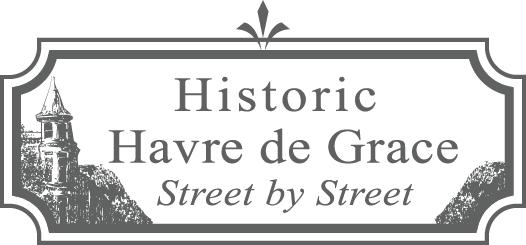Back to All Listings
817 Conesteo Street, Susquehanna Museum of Havre de Grace, c. 1840
Stop #1 on The Lafayette Trail
The original Lock House of the Southern Terminus of the Susquehanna and Tidewater Canal served two functions: a home for the Lock Tender and his family and an office for collecting tolls from transiting boats hauling coal, lumber, grain, iron, and other items from around 1840 to 1900. It sat on seven acres of waterfront. One of the first lock tenders was Charles B. Hitchcock (1817-1875), who originally came from Utica, New York, and was elected as a town commissioner several times. His wife was Mary Bartol Hitchcock (1816-1898), and together they owned the handsome Second Empire home at 667 Otsego Street for about 30 years. Probably the longest-serving lock tender was Carville Hynson Maslin (1832-1906), who came to Havre de Grace in 1865 to become the Canal’s lock tender. Along with his wife, Alice, he raised four sons and two daughters while tending the outlet lock for 30 years.
The canal was a major means of transportation during the Civil War, and vital to Union victory. Much of the land under and around the Lock House and its various outbuildings was “fill” made of sand, dirt, and clay. The canal company bought 38 lots of land from around the Lock House from Henry Barnes (1792-1858) and his wife, Sarah, in 1838 for $10,000, a huge amount of money at that time.
The canal comprised 29 locks, serving as a stairway of water elevators that allowed the mule-drawn canal boats (often weighing as much as 60 tons and more) to move up and down the 44 miles and 231 feet of elevation to Wrightsville, Pennsylvania. Although there was a certain type of design to the canal boats there also was variation depending on their use. They had to be strong enough to carry their freight down to Havre de Grace but after being unloaded many were dismantled, the wood sold, and the owner and crew sometimes had to walk back to Pennsylvania. There were regulations governing the boats—among them was that they had to have their names painted on the stern or other conspicuous place; the owner had to report in writing to the collector’s office what he was hauling, and its weight, so that the correct toll could be calculated; each boat had to sound a horn within a quarter mile of any lock intended to be passed; and the owner had to state if there were passengers and where they were going.
Most structures built to serve the canal’s operations are no longer standing but some foundations remain. One was William Walker’s Saloon, another was “Mr. Hopper’s Tavern,” and there was a “Hall’s Livery” at the Canal Basin. Not surprisingly, Coulehan & Hogan Fish Packing Plant was nearby. There also were numerous ice-harvesting operations in the general vicinity including Wm G. Whitney & Son’s Ice Factory in 1921.
The canal, as was the case with most other canals, was unable to meet railroad competition and fell into disuse. Much of the canal has been obliterated. Having been acquired by The Reading Railroad in the 1870s, it was sold to an agent of the Philadelphia Electric Company in 1902. The Lock House itself became a rental property to various people for about 70 years. One neighborhood child recalls playing in the Lock House back then, even when the first floor was under water. Lynda Barton Mauro says her great-grandparents, Stephen Thomas Dubree (1881-1960) and Florence Boyd Dubree, lived there in the late 1940s.
What is now a parking area just south of the Lock House had another small building on it for several years around the 1950s-1960s (see the photo). Vonda Elliott Craig grew up in it—she says her grandfather, Benjamin Elliott (born in 1888), pulled a one-room house out of the river during a hurricane (perhaps Hurricane Hazel in 1954) and set it down there for him and his wife, Mary. Vonda’s parents expanded the house to three rooms when they got married and Vonda grew up in it. The building, however, took off once more down the river during Hurricane Agnes in 1972.
The Susquehanna Power Company deeded the Lock House to the City of Havre de Grace in 1970. At that point a group of dedicated volunteers took over the historic building from the city and it became the Susquehanna Museum of Havre de Grace at the Lock House. It was entered on the National Register for Historic Places in 1976. In 1982 the building was rededicated and opened to the public as The Susquehanna Museum of Havre de Grace at the Lock House. It is listed on the National Register of Historic Places and the seven acres of North Park containing the Lock House and the canal lock are designated an historic area. The Lockhouse received an award from the Havre de Grace Historic Preservation Commission in 2019.
Running north under a canopy of woods and along the river and canal from the Lockhouse grounds is the 1.5-mile loop trail known as the “Joe K Trail,” marked by white blazes. It is named for Joe Kochenderfer, a former City Council member and devoted Trail Steward, who ensures its maintenance and regularly leads nature hikes along it.
